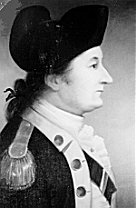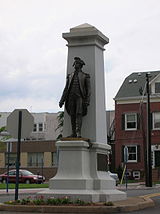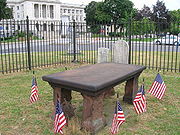
Enoch Poor
Encyclopedia

Brigadier general (United States)
A brigadier general in the United States Army, Air Force, and Marine Corps, is a one-star general officer, with the pay grade of O-7. Brigadier general ranks above a colonel and below major general. Brigadier general is equivalent to the rank of rear admiral in the other uniformed...
in the Continental Army
Continental Army
The Continental Army was formed after the outbreak of the American Revolutionary War by the colonies that became the United States of America. Established by a resolution of the Continental Congress on June 14, 1775, it was created to coordinate the military efforts of the Thirteen Colonies in...
in the American Revolutionary War
American Revolutionary War
The American Revolutionary War , the American War of Independence, or simply the Revolutionary War, began as a war between the Kingdom of Great Britain and thirteen British colonies in North America, and ended in a global war between several European great powers.The war was the result of the...
. He was a ship builder and merchant from Exeter, New Hampshire
Exeter, New Hampshire
Exeter is a town in Rockingham County, New Hampshire, United States. The town's population was 14,306 at the 2010 census. Exeter was the county seat until 1997, when county offices were moved to neighboring Brentwood...
.
Biography
Poor was born and raised in Andover, MassachusettsAndover, Massachusetts
Andover is a town in Essex County, Massachusetts, United States. It was incorporated in 1646 and as of the 2010 census, the population was 33,201...
. His father, Thomas Poor had been part of the 1745 expedition that captured Louisburg, Nova Scotia, during King George's War
King George's War
King George's War is the name given to the operations in North America that formed part of the War of the Austrian Succession . It was the third of the four French and Indian Wars. It took place primarily in the British provinces of New York, Massachusetts Bay, New Hampshire, and Nova Scotia...
. In 1755 young Poor enlisted as a private in one of the Massachusetts units raised to accompany Jeffrey Amherst's expedition to retake it during the French and Indian War
French and Indian War
The French and Indian War is the common American name for the war between Great Britain and France in North America from 1754 to 1763. In 1756, the war erupted into the world-wide conflict known as the Seven Years' War and thus came to be regarded as the North American theater of that war...
. His unit enforced the expulsion of the Acadians
Great Upheaval
The Expulsion of the Acadians was the forced removal by the British of the Acadian people from present day Canadian Maritime provinces: Nova Scotia, New Brunswick, and Prince Edward Island...
. After the war, he came home to Andover, but only briefly. Poor eloped with Martha Osgood, and the newlyweds settled in Exeter.
Poor supported the separatists as early as the Stamp Act
Stamp Act 1765
The Stamp Act 1765 was a direct tax imposed by the British Parliament specifically on the colonies of British America. The act required that many printed materials in the colonies be produced on stamped paper produced in London, carrying an embossed revenue stamp...
protests in 1765. He served on various committees for the town throughout the period of rising rebellion. In 1775 he was twice elected to the provincial Assembly. When the Battle of Lexington caused the assembly to call for three regiments of militia, Poor became the colonel of the 2nd New Hampshire Regiment
2nd New Hampshire Regiment
The 2nd New Hampshire Regiment, also known as the 8th Continental Regiment, was formed in early May of 1775, as the second of three Continental Army regiments raised by the state of New Hampshire during the American Revolutionary War. Its first commander was Colonel Enoch Poor, with Joseph Cilley...
.
While the other regiments under colonels John Stark
John Stark
John Stark was a New Hampshire native who served as a major general in the Continental Army during the American Revolution. He became widely known as the "Hero of Bennington" for his exemplary service at the Battle of Bennington in 1777.-Early life:John Stark was born in Londonderry, New...
and James Reed
James Reed (soldier)
James Reed was a military officer in the French and Indian War and the American Revolution, rising to the rank of brigadier general in the latter conflict....
were sent to Boston
Boston
Boston is the capital of and largest city in Massachusetts, and is one of the oldest cities in the United States. The largest city in New England, Boston is regarded as the unofficial "Capital of New England" for its economic and cultural impact on the entire New England region. The city proper had...
, the 2nd was stationed at Portsmouth
Portsmouth, New Hampshire
Portsmouth is a city in Rockingham County, New Hampshire in the United States. It is the largest city but only the fourth-largest community in the county, with a population of 21,233 at the 2010 census...
and Exeter. After the Battle of Bunker Hill
Battle of Bunker Hill
The Battle of Bunker Hill took place on June 17, 1775, mostly on and around Breed's Hill, during the Siege of Boston early in the American Revolutionary War...
, they were also sent to Boston, arriving on June 25. In the summer of 1775, the unit was absorbed into the Continental Army
Continental Army
The Continental Army was formed after the outbreak of the American Revolutionary War by the colonies that became the United States of America. Established by a resolution of the Continental Congress on June 14, 1775, it was created to coordinate the military efforts of the Thirteen Colonies in...
. They were soon ordered into the Northern Department and went with General Richard Montgomery
Richard Montgomery
Richard Montgomery was an Irish-born soldier who first served in the British Army. He later became a brigadier-general in the Continental Army during the American Revolutionary War and he is most famous for leading the failed 1775 invasion of Canada.Montgomery was born and raised in Ireland...
's invasion of Canada
Invasion of Canada (1775)
The Invasion of Canada in 1775 was the first major military initiative by the newly formed Continental Army during the American Revolutionary War. The objective of the campaign was to gain military control of the British Province of Quebec, and convince the French-speaking Canadiens to join the...
.
After the disaster in Canada, Poor led the survivors of his regiment in early 1776 back to Fort Ticonderoga
Fort Ticonderoga
Fort Ticonderoga, formerly Fort Carillon, is a large 18th-century fort built by the Canadians and the French at a narrows near the south end of Lake Champlain in upstate New York in the United States...
. After refitting and recruiting, the unit was renamed as the 8th Continental regiment and joined Washington's main army in December 1776 at winter quarters near Morristown, New Jersey
Morristown, New Jersey
Morristown is a town in Morris County, New Jersey, United States. As of the 2010 United States Census, the town population was 18,411. It is the county seat of Morris County. Morristown became characterized as "the military capital of the American Revolution" because of its strategic role in the...
.

Continental Congress
The Continental Congress was a convention of delegates called together from the Thirteen Colonies that became the governing body of the United States during the American Revolution....
named Poor a brigadier general on February 21, 1777. That spring, his brigade of three New Hampshire (1st
1st New Hampshire Regiment
The 1st New Hampshire Regiment was an infantry unit that came into existence on 22 May 1775 at the beginning of the American Revolutionary War. John Stark was the regiment's first commander. The unit fought at Chelsea Creek and Bunker Hill in 1775. On 1 January 1776, while engaged in the Siege of...
, 2nd
2nd New Hampshire Regiment
The 2nd New Hampshire Regiment, also known as the 8th Continental Regiment, was formed in early May of 1775, as the second of three Continental Army regiments raised by the state of New Hampshire during the American Revolutionary War. Its first commander was Colonel Enoch Poor, with Joseph Cilley...
and 3rd
3rd New Hampshire Regiment
The 3rd New Hampshire Regiment, also known as the 2nd Continental Regiment, was authorized on 22 May 1775, organized 1-8 June 1775, and adopted into the Continental Army on 14 June, 1775, as the third of three regiments raised by the state of New Hampshire during the American Revolution...
) and two New York regiments (2nd
2nd New York Regiment
The 2nd New York Regiment was authorized on May 25, 1775, and formed at Albany from June 28 to August 4 for service with the Continental Army under the command of Colonel Goose Van Schaick...
and 4th
4th New York Regiment
The 4th New York Regiment was authorized on May 25, 1775 and organized from June 28 to August 4 from Westchester, Dutchess, Kings, Queens, and Richmond counties for service with the Continental Army under the command of James Holmes...
)was sent back to Ticonderoga. He withdrew with the rest of Arthur St. Clair
Arthur St. Clair
Arthur St. Clair was an American soldier and politician. Born in Scotland, he served in the British Army during the French and Indian War before settling in Pennsylvania, where he held local office...
's force of July 5. Moving south, they joined General Horatio Gates
Horatio Gates
Horatio Lloyd Gates was a retired British soldier who served as an American general during the Revolutionary War. He took credit for the American victory at the Battle of Saratoga – Benedict Arnold, who led the attack, was finally forced from the field when he was shot in the leg – and...
before the Battle of Saratoga
Battle of Saratoga
The Battles of Saratoga conclusively decided the fate of British General John Burgoyne's army in the American War of Independence and are generally regarded as a turning point in the war. The battles were fought eighteen days apart on the same ground, south of Saratoga, New York...
, and his brigade was expanded by two regiments of Connecticut
Connecticut
Connecticut is a state in the New England region of the northeastern United States. It is bordered by Rhode Island to the east, Massachusetts to the north, and the state of New York to the west and the south .Connecticut is named for the Connecticut River, the major U.S. river that approximately...
militia (Cook's and Latimer's).
In the first engagement of Saratoga, the Battle of Freeman's Farm, Poor's brigade was the first to come to the aid of Daniel Morgan
Daniel Morgan
Daniel Morgan was an American pioneer, soldier, and United States Representative from Virginia. One of the most gifted battlefield tacticians of the American Revolutionary War, he later commanded troops during the suppression of the Whiskey Rebellion.-Early years:Most authorities believe that...
's attack. Poor held the American left flank, extending into the woods and even wrapping around the British position. They performed well, keeping General Simon Fraser's regulars engaged while Benedict Arnold
Benedict Arnold
Benedict Arnold V was a general during the American Revolutionary War. He began the war in the Continental Army but later defected to the British Army. While a general on the American side, he obtained command of the fort at West Point, New York, and plotted to surrender it to the British forces...
led attacks on the central column.
In the second engagement, the Battle of Bemis Heights, Poor's brigade was in General Benjamin Lincoln
Benjamin Lincoln
Benjamin Lincoln was an American army officer. He served as a major general in the Continental Army during the American Revolutionary War...
's division on the left (western) end of the American line. They were closest to the center of the advancing British, so they came under fire from the grenadier battalion of the British center. The fire was ineffective, so Major John Dyke Acland
John Dyke Acland
Major John Dyke Acland , son of Sir Thomas Dyke Acland, 7th Baronet, was a British officer who fought in the American War of Independence and, later, a politician....
led the grenadiers in a bayonet charge. Poor held fire until they came very close, then opened up with the massed fire of his 1,400 men. These were the first American shots in the battle. The charge was completely broken, and Acland himself fell wounded. With this collapse of Burgoyne's center, the Americans captured the wounded Acland and Major Williams along with the column's artillery. Poor then turned to his left and gave support to Ebenezer Learned
Ebenezer Learned
Ebenezer Learned was a brigadier general in the American Continental Army during the Revolutionary War.-Early life and career:...
and Morgan's men.

Valley Forge
Valley Forge in Pennsylvania was the site of the military camp of the American Continental Army over the winter of 1777–1778 in the American Revolutionary War.-History:...
. He led the last maneuvers in the Battle of Monmouth
Battle of Monmouth
The Battle of Monmouth was an American Revolutionary War battle fought on June 28, 1778 in Monmouth County, New Jersey. The Continental Army under General George Washington attacked the rear of the British Army column commanded by Lieutenant General Sir Henry Clinton as they left Monmouth Court...
on June 28, 1778. He accompanied the Sullivan Expedition
Sullivan Expedition
The Sullivan Expedition, also known as the Sullivan-Clinton Expedition, was an American campaign led by Major General John Sullivan and Brigadier General James Clinton against Loyalists and the four nations of the Iroquois who had sided with the British in the American Revolutionary War.The...
in 1779, leading a brigade in the victory at Newton
Battle of Newtown
The Battle of Newtown , also known as the Battle of Chemung, was the only major battle of the Sullivan Expedition, an armed offensive led by General John Sullivan that was ordered by the Continental Congress to end the threat of the Iroquois who had sided with the British in the American...
.
Afterward Poor was assigned to Lafayette's division and mainly saw garrison duty in New Jersey
New Jersey
New Jersey is a state in the Northeastern and Middle Atlantic regions of the United States. , its population was 8,791,894. It is bordered on the north and east by the state of New York, on the southeast and south by the Atlantic Ocean, on the west by Pennsylvania and on the southwest by Delaware...
. Some sources say Poor was shot in a duel near Hackensack, New Jersey
Hackensack, New Jersey
Hackensack is a city in Bergen County, New Jersey, United States and the county seat of Bergen County. Although informally called Hackensack, it was officially named New Barbadoes Township until 1921. As of the 2010 United States Census, the city population was 43,010....
, on September 6, 1780, and died two days later from the wound, although the Army surgeon reported that Poor died from typhus
Typhus
Epidemic typhus is a form of typhus so named because the disease often causes epidemics following wars and natural disasters...
. Poor was buried in the First Reformed Dutch Church Cemetery in Hackensack. George Washington
George Washington
George Washington was the dominant military and political leader of the new United States of America from 1775 to 1799. He led the American victory over Great Britain in the American Revolutionary War as commander-in-chief of the Continental Army from 1775 to 1783, and presided over the writing of...
and Lafayette both attended his funeral. When Washington wrote to inform Congress of Poor's death, he noted that "He was an officer of distinguished merit, one who as a citizen and soldier had every claim to the esteem and regard of his country."

